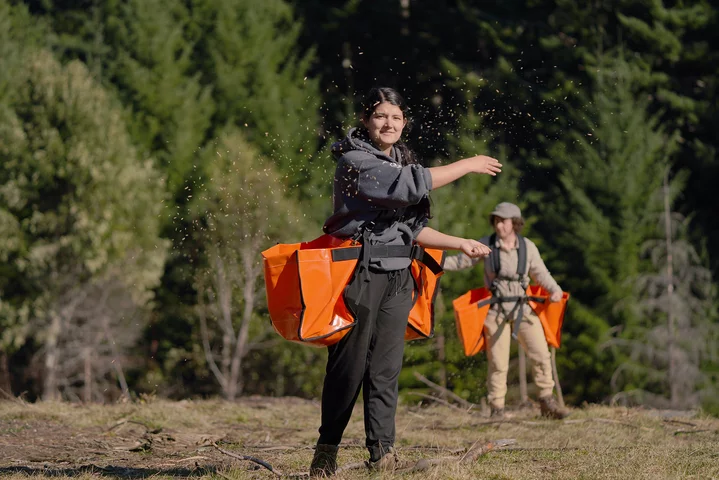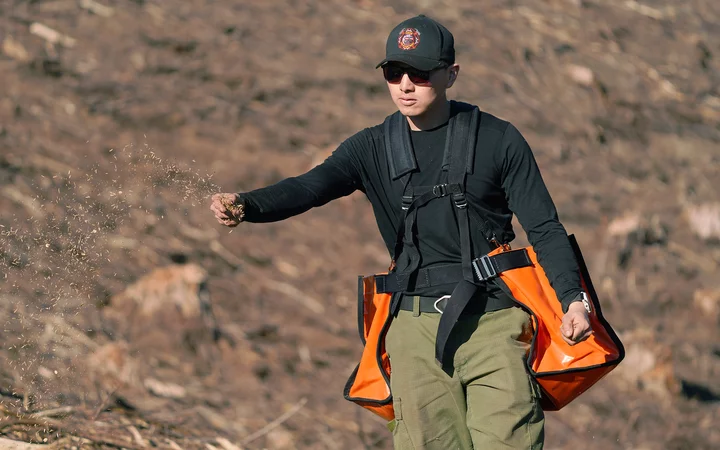Kayla Salinas from the Yurok Wildlife Department hand sows native plant seed on Steven’s Prairie. Photos: Yurok Tribe.
Press release from the Yurok Tribe:
This week, the Yurok Tribe started implementing a critical phase of an ongoing project to restore more than 60 acres of prairie habitat that once blanketed a ridge above Blue Creek.
Staff from three of the Tribe’s natural resources departments are hand-sowing 900 pounds of native plant seed over Steven’s Prairie as part of an integrated effort to reestablish the grassland ecosystem and renew two-miles of salmon and steelhead habitat in Blue Creek, the most productive Klamath River tributary on the Yurok Reservation.
“Our goal is to restore the meadows and prairies to increase plant diversity and abundance that will provide habitat and food for wildlife from insects to elk. Furthermore, many of the prairie plants are used by Yurok people for food, medicine, and utilitarian purposes. Where our wildlife thrives, we thrive, as members of the same ecological community,” says Tiana Williams-Claussen, the Yurok Wildlife Department Director.
A multidisciplinary team of experts from the Yurok Tribe’s Fisheries, Wildlife, Watershed Restoration & Roads, Environmental, Cultural, Forestry and Fire Departments are collaborating on the pivotal Steven’s Prairie Project. Prior to the project, nearly all of the historic prairie was covered in young Douglas firs, which were removed and incorporated into the restoration effort on Blue Creek.
“The whole trees will create excellent habitat for juvenile salmon and steelhead,” explains Sarah Beesley, a Senior Fisheries Biologist for the Yurok Fisheries Department’s Lower Klamath Program.
Steven’s Prairie on the map.
Steven’s Prairie
Since European contact, the Yurok Tribe has lost 99 percent of all prairies on the reservation and adjacent lands, due to industrial timber operations, overly aggressive fire suppression and acentury-long prohibition on traditional burning. Most fish and wildlife populations declined precipitously during the same time period.
The Steven’s Prairie project is the Tribe’s first grassland restoration initiative. The project broke ground this summer when Yurok Watershed Restoration & Roads Department heavy equipment operators uprooted Douglas firs and transported around 400 whole trees with intact root wads down to Blue Creek. The Fisheries Department has already placed some of the trees in strategic locations within the lower two miles of the stream to improve ecological function and enhance fish spawning and rearing habitat.
Over the last three weeks, the Yurok Fire, Environmental, Wildlife, Watershed & Roads departments burned the leftover woody debris and the small remnant of the original prairie.
“These are lands our ancestors burned hundreds of years ago,” says Yurok Fire Department Division Chief Blaine McKinnon. “I would love to come back out here one day to hunt with my son and be able to say I had a part in restoring that prairie to bring back elk and bring back deer to this area.”
The light layer of ash will further enrich the already fertile prairie soil, a perfect planting medium for the 20 different plant species selected for the Steven’s Prairie project. The plant species include deep-rooted bunch grasses, forbs and flowering herbs, such as blue wild rye (Elymus glaucus), herhhlkerh or Indian Potato (Brodiaea laxa) and showy milkweed (Asclepias speciosa). These plants perform many different functions like fixing nitrogen in the soil to support plant growth, providing food for wildlife, and attracting pollinators, including the Mardon skipper, listed as endangered under the California Endangered Species Act, and the monarch butterfly which is currently under review for federal listing as threatened.
Historically, the Tribe used cultural burning to maintain Stevens Prairie, where tribal people hunted grouse, deer and elk. It was also a gathering place for edible and medicinal plants. Prairies support a vast array of plant species and offer large quantities of forage for wildlife, including deer, elk, and the California condor, not to mention small mammals, songbirds and amphibians. Prairies also provide an ideal setting for eagles and hawks to hunt prey.
“In the 25-plus years that I’ve been involved in watershed restoration, this project is the most satisfying. We are creating habitat that will benefit all native wildlife and our community for many generations to come,” says Yurok Watershed & Roads Department Director Richard Nelson.
The Steven’s Prairie project site is temporarily gated to give plants and animals time to repopulate the area. Next year, the Tribe plans to heal many more acres of prairie habitat. Once the projects are complete, the restored prairies are expected to help rebuild deer and elk herds on the reservation and adjacent Yurok managed lands. The restoration of the prairies will also allow more water to enter Blue Creek.
To evaluate the project’s effectiveness, Yurok Tribe Environmental Department Manager Joe Hostler is collecting data throughout the prairie restoration process, while occupying a leadership role within the design and implementation teams. The data will also inform future prairie renewal initiatives. Hostler interviewed the tribal elders who proposed the Steven’s Prairie project years prior.
The Steven’s Prairie restoration project is the first step in returning the prairies that laced the ridgelines of Yurok Territory since time immemorial.
Yurok Firefighter Nah-tes Jackson helps restore Steven’s Prairie.


CLICK TO MANAGE